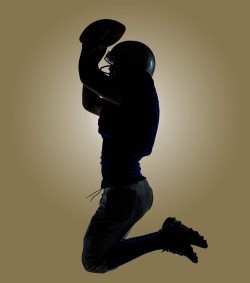The Heart of Louisiana: Hokie Gajan
At its very best, sports offers more than entertainment — it offers personification and exemplification of who we are and what we can do at our best.

Louisianans perhaps sometimes feel their state does not get its due. Perhaps there are good reasons for that, but what we lack in some key, dry statistics, we make up for on game day. From Monroe to Baton Rouge to New Orleans, Louisianans appear without signal on Fridays, Saturdays and Sundays for football, and they pour their heart out for their teams and their heroes, maybe to show how much they really have to offer. Rarely however, is that passion matched and returned on the field itself. That is why the death of Hokie Gajan, former LSU Tiger and New Orleans Saint, on a Monday night in April, came as such a blow. On Saturdays and Sundays, this true Louisianan showed what Louisiana was capable of.
A truck of a man, but not as large as some players in the NFL, Gajan carried 10 times the energy his body should have offered, throwing every ounce of desire he could muster into every play. At LSU, Hokie strode the field in No. 47, cloaked in purple and gold. He made the way for Heisman Trophy contender and SEC MVP Charles Alexander in head coach Charlie McClendon’s power-I offense. Later under Jerry Stovall, he became a very unconventional lead running back, perhaps best known for breaking more tackles than yards gained on many occasions, in the days of tear-away jerseys leaving shreds of cloth and defenders in his rough wake.
For the Saints, wearing No. 46, he set the record for average yards per carry for a season and a career (finally broken by only Darren Sproles). At times, like the 1983 game versus the Atlanta Falcons when he scored two touchdowns and plowed the way for a third, he was an unstoppable force who could dominate a game. At other times, like the 1984 game at the Dallas Cowboys when he burst through a seam for a 62-yard touchdown untouched, he showed surprising grace and versatility that could shock an opponent. Throughout, he always showed heart. On the field, he ran with honesty, if there is such a thing, and, with head coach Bum Phillips, he gave Saints fans their first glimpse at winning, even if they never did actually make the playoffs.
That versatility and heart later showed in the Saints scouting department and in the broadcast booth. Hokie spent 13 years as a scout for the Saints, which is a rare feat of stable dependability and success in an often unreliable field. Making judgement calls on prospects and calling Saints games after his playing career was over, Hokie delivered every play and offered every opinion like he fairly saw it. Just as importantly, as he had played like he knew how much it meant to the people he was playing for, when he opined, he did it the same way — offering the honest perspective of someone who cared about the game, not as someone speaking for the team or front office or defending it, but rather saying what was right or wrong because that was how he saw the truth. He never fooled his listeners. For that, his audience was thankful and returned his devotion.
As Hokie had withstood the blows of would-be tacklers, from 2000 on, he handled the toil of calling every single Saints play, often empathizing with the plight of the average Saints fan with humor and shared suffering. One time, he aptly described the attributes needed to be a Saints fan: “A good pair of binoculars, a media guide and a bottle of Jack Daniels.” As a broadcaster, Hokie carried on the tradition of Hap Glaudi and Buddy Diliberto, echoing the sounds of the homes and neighborhoods from which they hailed, as well as their listeners from St. Bernard, Gentilly and Acadiana, our very own Yogi Berra with Hokieisms. Some good examples include describing a player who was “Running around down there like a sprayed roach,” and “Every time the smoke has cleared, something else rears its ugly head,” and “If this team ever won the Super Bowl, Mardi Gras would look like a church picnic.” And he did indeed recount the tale of the Saints doing just that, as he called the game the day the Saints marched into the promised land in Super Bowl XLIV.
In his final battle in a long line of opponents, the toughest man in Louisiana faced the deadliest foe, cancer, in the admirable way that everyone had learned to expect. Having learned in November of his condition, he appeared for his regularly scheduled broadcasts, until he could no longer do so, stating, “I’m going to keep doing my job and keep doing what I enjoy, which is watching the game.” With the loss of former defensive end Will Smith following hard on the heels of the loss of Gajan, the city of New Orleans closed a chapter in its sports history, one in which the impossible had been rebuked before them on the gridiron. The proof of what Louisiana can do and what it can be — determined, honest, proud, humble, indefatigable — lived in Gajan, and, in his memory, it will continue to live on.
